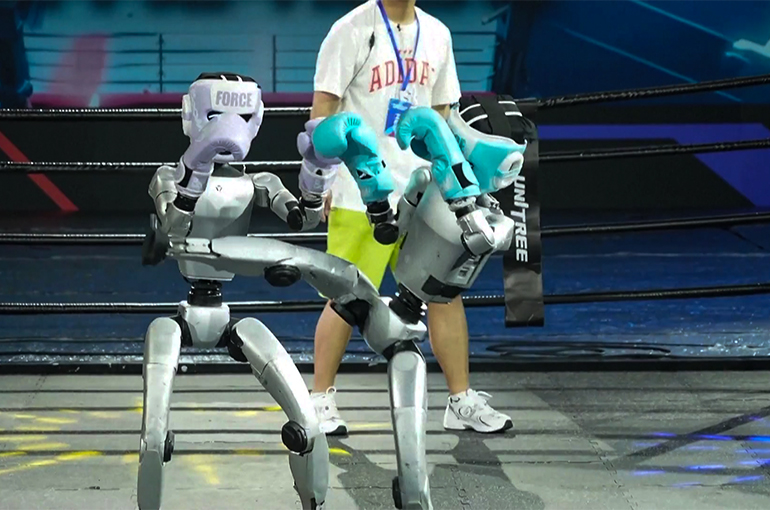 China’s Unitree Hosts World's First Android Boxing Contest
China’s Unitree Hosts World's First Android Boxing Contest(Yicai) May 26 -- Unitree Robotics has staged the world’s first combat competition between humanoid robots, with the event serving as a real-world test of the Chinese startup's machines.
The event, broadcast live on China Central Television from Hangzhou late yesterday, featured four Unitree G1 androids remotely controlled by human operators, with matches consisting of three two-minute rounds. Only hits to the head or torso were counted, with hand strikes earning one point and leg strikes three.
Standing around 1.3 meters tall and weighing 35 kilograms, the G1 has 23 degrees of freedom and a maximum knee joint torque of 90N·m, according to Unitree, which debuted the robot last year.
“Combat robots need to predict their opponents' intentions in real-time in rapidly changing environments, adjust their stances, and make the right decisions for subsequent action,” Zhou Di, a member of the China Computer Federation's smart robotics professional committee, told Yicai.
This ability helps robots to actively avoid obstacles in industrial and rescue situations, which directly affects how reliable they are in those settings, accordion to Zhou.
“Boxing matches test robots' mechanical structure, motion control, sensor fusion, and intelligent decision-making capabilities, including dynamic balance, impact resistance, and multimodal perception coordination,” Zhou said.
Despite being remotely operated by humans, there were sine surprises during the matches. One android lost its footing and fell after missing a punch, another got entangled in the ring ropes while retreating to find a corner, and two got stuck together while grappling, requiring the referees to separate them.
"These phenomena reveal the shortcomings in the robots' control and real-time perception capabilities," Zhou pointed out.
Even though the G1 has mastered some combat moves through reinforcement learning, even a millisecond’s delay between the sensor capturing the opponent's position and the joint executing the action will put an attack’s timing off, Zhou said.
Collisions and impacts during combat expose weaknesses in motors and sensors, prompting further improvements in anti-interference design and material upgrades, according to Zhou. “Only with coordinated software and hardware can the G1 successfully complete the match.”
Regarding Unitree's choice to use the smaller G1 over the H1, which stands more than 1.7 meters tall, a robot algorithm engineer told Yicai that the G1 offers advantages in algorithm optimization efficiency, making it more suited to the rapid iteration required in combat scenarios. "The H1 has an edge in industrial applications requiring high load capacity but is not as suitable for combat," the person noted.
Unitree likely carried out special algorithm optimization for this competition's specific scenarios to improve the robots' fault tolerance during combat, the engineer said, adding that the event was a chance to test the coordination between robotic intelligent hardware and software.
For most of the competition, the G1 robots could quickly and stably stand up within five seconds after falling, Yicai observed.
Editors: Tang Shihua, Martin Kadiev